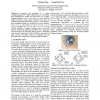Free Online Productivity Tools
i2Speak
i2Symbol
i2OCR
iTex2Img
iWeb2Print
iWeb2Shot
i2Type
iPdf2Split
iPdf2Merge
i2Bopomofo
i2Arabic
i2Style
i2Image
i2PDF
iLatex2Rtf
Sci2ools
ICRA
2002
IEEE
2002
IEEE
Locomotion and Navigation of a Planar Walker Based on Binary Actuation
: Locomotion and navigation of a surface walking/climbing robot – Planar Walker, based on a novel planar 8-bar mechanism are studied. The robot moves on a surface through decoupled transverse gaits and turning gaits with finite lengths and finite rotation angles. Motions of the gaits are modeled using planar rigid motion group SE(2). Three point-topoint navigation methods are developed for various situations: Simple Line of Sight (SLS), Simulated Annealing Accurate Planning (SAAP), and Localized Hybrid Accurate Planning (LHAP) algorithms. Computer simulation shows that SAAP produces accurate gait sequences and LHAP saves computation time and resources for long-range targets. However, experiment shows that SLS outperforms SAAP and LHAP as the number of gaits becomes the major criteria in evaluating the gait performance due to imprecision of individual gait movements.
| Added | 15 Jul 2010 |
| Updated | 15 Jul 2010 |
| Type | Conference |
| Year | 2002 |
| Where | ICRA |
| Authors | I-Ming Chen, Song Huat Yeo |
Comments (0)

